Art of the Genre: Top 10 Fantasy Artists of the Past 100 Years
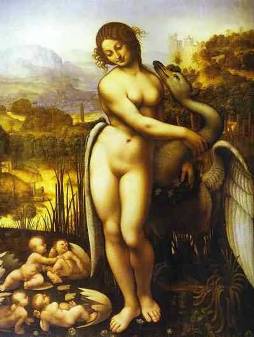
Ok, so after hanging up with him I yelled for Kandline to bring me the LA Times, which she was currently using to keep nail polish from dripping on her far too short skirt. After she made her way into my office I tried to convince her to help me determine what might be an interesting top ten. She suggested ‘Top 10 Disney stars who have a chance at winning an Oscar’, but Ryan Harvey shot that one down from his office next door as the sound of Miley Cyrus from the reception desk delivered wooden lines like a chorus of malevolent crows.
After some further consideration, these without my secretary’s help, I finally decided to go with the old standby of an art related article. That being said, I’m happy to bring you the Top 10 Fantasy Artists of the Past 100 Years.
Now you might be wondering how I came into possession of this list. Well, I went deep into my contacts and put together fifty names that consisted only of artists, art directors, convention organizers, and RPG publishers. Not a single voter on this panel didn’t have a vested interest in the topic at hand, and when all was said and done my list contained over fifty incredible names, but alas, I was only looking for 10, so that’s where we are. Oh, and if you’re wondering, no, I didn’t vote [no matter how much I would have loved to].
In all, I think the list not only contains the usual suspects, but also has some people you wouldn’t normally think of off the top of your head. It’s a truly wonderful list, and at the end of this piece I’ve decided to include all the artists who received at least one vote so that you can see the diversity that came out of the replies.
Number 10: Roy C. Krenkel, Boris Vallejo, and Manuel Sanjulian
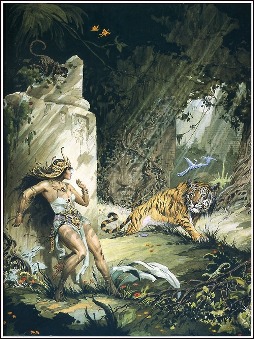
Amazingly these artists came in at a dead heat to form a three-way tie for tenth place. Since I didn’t put in a factor for a tiebreaker, and I just didn’t feel right about cutting any one of them, I’ve decided to show you each! Yeah, it’s kind of like going into overtime.
Roy C. Krenkel: (1918-1983) was an American illustrator who is known for his close association with another American fantasy icon, Frank Frazetta. In the 1950s Krenkel graced the pages of magazines such as Weird Fantasy, Weird Science, and Weird Science-Fantasy and his work helped define pulp fanzines of that age. More a cartoonist than a cover artist, some of Krenkel’s most profound work was done in black and white, and the art of his lines never fails to amaze.
My Take: I like Krenkel, and as a huge fan of black and white work, I couldn’t be happier to see him included in this list. He did some outstanding work in the science fiction field as well, and I think that his women are true icons of a pin-up style inside the fantasy age.
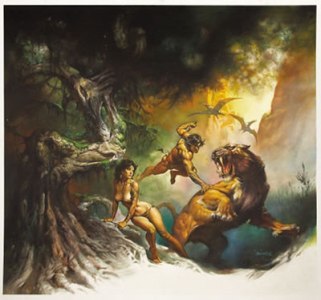
My Take: Boris did my favorite B movie poster of all time, that of Deathstalker II with Monique Gabrielle and John Terlesky. I absolutely love the style employed in his early work for the Gor novels, plus the simple fact that he is still putting out art and attending shows today says a great deal about his passion and dedication to the craft.
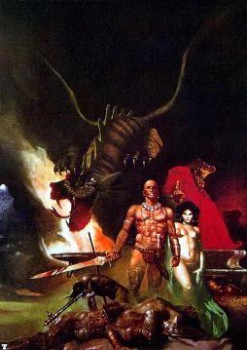
My Take: Well, Vampirella… need I say more? He brings a sense of movement and sex appeal to his work that isn’t captured by too many others, and I think is study of the female form is off the chart. As I’m too young to have delved deeply into horror fanzines, I’ll have to leave praise for his work there to a more practiced pro, Jeff Easley who says “The ability to unlock the surface of the painting ground and transform dabs of pigment into a new world at least as vivid as the one we live in is the capability most highly sought after by many artists. Sanjulian does this seemingly without effort and always without fail.” Well said!
Number 9: Greg and Tim Hildebrandt (Greg 1939-Present, Tim 1939-2006) are American born twin brothers who began their professional painting career together around 1960. 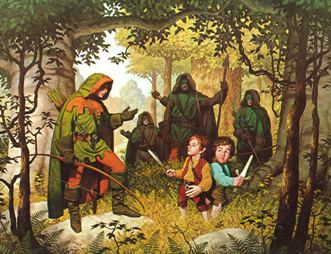
My Take: Well, I was always taken with their early work on Shannara, and although I could never actually get through one of those books, the cover art stands out in my mind as a beautiful representation of an epic fantasy world. Greg and Tim are certainly members of elite company, and their ability to share the craft of creation is in my opinion one of the more intriguing parts of their success.
Number 8: Jeffrey Catherine Jones (1944-2011) is an American artist who produced over 150 fantasy and science fiction covers during her career. 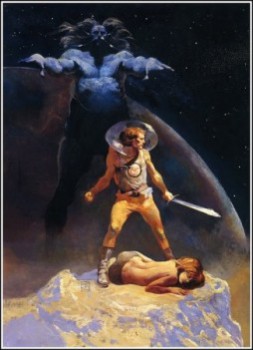
My Take: This is a tough one because I’m just not that familiar with her art other than what I’ve studied as I put this article together. I will say this, there is form work here that makes me see a completely new possibility for art, and as I’m very familiar with the work of artist Rick Berry, I now have a much better understanding of what Rick does and where his kind of art has its roots.
Number 7: Larry Elmore (1948-Present) is an American fantasy artist best known for his work on the role-playing game Dungeons and Dragons through the 1980s. His oil paintings helped define the genre of role-playing games as he did covers for science fiction (Star Frontiers), gaming inspired novels (Dragonlance), fantasy magazines (Dragon), before moving on to video game design (Everquest) and collectable cards (Magic: The Gathering). 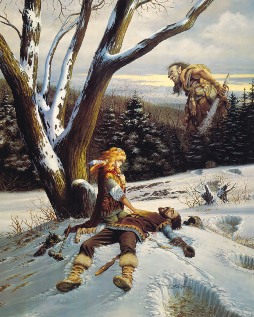
My Take: Well, Larry is Larry, and I’ve had the pleasure of working with him on a couple of occasions and each time it’s more fun. His work is still dominate in the industry he’s called home for more than 30 years, and you would be hard pressed to find a gamer of any age who can’t pick out the beauty of an Elmore painting. He has taken lovely to an entirely new level, and I have to say I was very pleased to see him place in this list.
Number 6: Arthur Rackham (1867-1937) is and English illustrator who created his own style of art using blocking and layering to create photographic-like images. His illustration work was used in plates for classic books including the Fairy Tales of the Brothers Grimm, Gulliver’s Travels by Jonathan Swift, Rip van Winkle by Washington Irving, and Alice’s Adventures in Wonderland by Lewis Carroll. 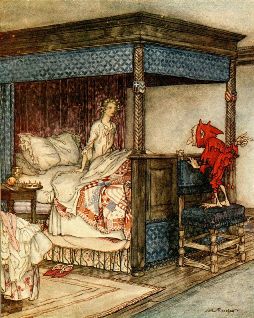
My Take: Well, it’s great to see that not every artist on this list was from the U.S., although I must say that fantasy in general is dominated by an American market [although oddly the two biggest fantasy writers of all time by an enormous margin are English, ala Tolkien and Rowling]. Again, I love black and white line art, and Rackham is a master of it, his style of using shadowed-stuff makes you think you’re looking at some old movie in a archaic viewer where only one of your eyes can see into.
Number 5: Brom (1965-Present) is an American artist known for his work in fantasy that mixes styles with a gothic format. 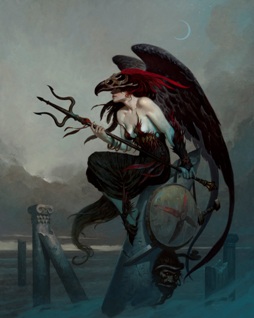
Brom’s initial delve into fantasy came with the gaming company TSR in the early 1990s, and his work on the Darksun Campaign Setting brought a dark apocalyptic future to fantasy for the first time. His work continued with contributions to darker gaming systems such as Deadlands and Vampire the Masquerade. He’s also created his own fiction novel using his gothic style with The Child Thief.
My Take: Brom is freaky, but I love him, and if it weren’t for him I’m going to go so far as to say that shiny vampires might not be burning up the bestseller lists. His gothic movement, trench coats, leather, and pale skin we keys to bringing dark fantasy and probably even urban fantasy into the light of day during the early 90s. There is no mistaking his talent, and the genre he chose to display his skills in just keep growing by the day… or should I say night?
Number 4: NC Wyeth (1882-1945) is a turn of the century American illustrator who was a pupil of American legend Howard Pyle. 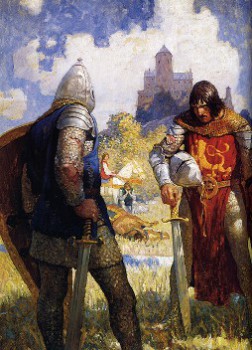
My Take: My grandfather loved Louis L’amour and basically anything that had to do with the old west. Wyeth gives us a window into this world, and I can see why many consider it to be a fantasy one because so many of the stories involved are dramatizations of expanded reality. His work frames a period that lives in legend among us all, and although we may have moved into a space age, Wyeth’s work keeps us grounded with incredible detail and color that bleeds into the page.
Number 3: Keith Parkinson (1958-2005) was an American painter who worked alongside Larry Elmore in the dawn of the oil period at the gaming giant TSR. 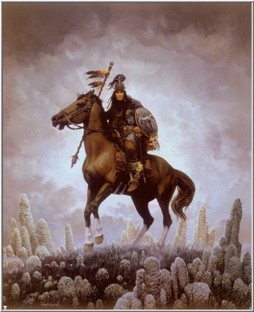
My Take: Ah Keith… if only I’d had the chance to know you… Keith was taken far too early from the artistic stage, and yet his work has obviously touched the great bulk of our voters. To me, Keith’s work sets the stage for my youth, and over the years I’ve come to love almost every image I’ve ever seen of his. It wouldn’t take much to have me detail a massive roll of all his works that mean something special to me, but it’s probably the same with the bulk of gamers from 1980 on.
Number 2: Michael Whelan (1950-Present) is a 16 time Hugo Award winning American painter who has helped define novel covers from 1980 forward. 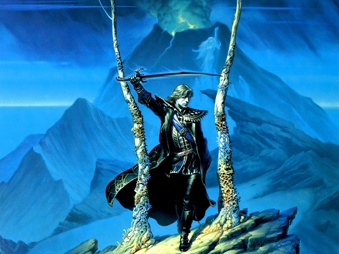
My Take: There are those people in the world of modern media that become connected to a subject more so than any other. In this fashion Don Lafontaine IS the voice of action movie trailers, Michael Buffer makes us all want to ‘get ready to rumble!’, and John Williams has somehow created the soundtrack to all our lives. Michael Whelan is this kind of person, the man who has single-handedly become ‘it’ for novel covers that define the genre.
Number 1: Frank Frazetta (1928-2010) is an American painter best known for his work defining Robert E. Howard’s Conan. His contributions on Conan transformed the fantasy genre in the 1960s, and he can be directly credited with creating what many consider to be the true stylistic essence of all swords and sorcery painting. His influence is so profound that it can be argued four members of this Top 10 actually maintain their position from using Frazetta’s techniques in their own work. His work has become so iconic that it transcended fantasy to become a part of pop culture. 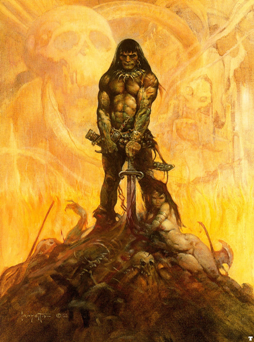
My Take: Man, where do I start? Frazetta needs no introduction, and his work certainly doesn’t require my take, but I guess I’ll give it nonetheless. To me his has created a kind of central core that all other fantasy artists of this modern age pinwheel off of. If there were a dozen ‘Top 10’ lists about art, like form, composition, brushwork, color, etc, Frazetta would probably be at the top of each. That is what he means to the field, and if you ever have the chance to set down and see an original painting, take the time to just be quiet and enjoy it because if you think his book covers sing, you haven’t seen anything until the depth of an original stares back at you.
So there you have it, the Top 10 Fantasy Artists of the past 100 Years, but if you feel someone was left out, then have a look at the names that got votes but didn’t make it into the list above. I seriously doubt anyone was totally missed.
J. Allen St. John, Maxfield Parrish, Moebius, Alan Lee, Frank Kelly Freas, Jeff Easley, John Howe, Donato Giancola, Virgil Finlay, Howard Pyle, Tim Bradstreet, Brian Froud, Roger Dean, Jude Jude Palencar, Wayne Reynolds, Todd Lockwood, Dave Dorman, Phil Hale, Stephen Fabian, Hayao Miyazaki, Clyde Caldwell, Bernie Wrightson, Richard Corben, John Baur, Patrick Woodruffe, Eva Widermann, Steve Prescott, Erol Otus, Tyler Walpole, James Ryman, Ben Wooten, Ed Valigursky, Ed Emshwiller, Ian McCaig, James Gurney, Kevin Walker, Paul Bonner, Jack Kirby, Paul Lehr, Al Williamson, Enric Torres Prat, Wallace Wood, James Bama, Rodney Matthews, David Mattingly, Bob Peake, Charles Bragg, Yoshitaka Amano, Justin Sweet, Chris Achilleos, Juan Gimenez, Syd Mead, Maurice Sendak, Hal Foster, H.R. Giger, Philippe Druillet, Steve Youll, M.C. Esher, Edward Gorey, Arthur Wardle, Rien Poortvliet, James Gurney, Stan Winston, Mike Mignola, Joseph Clement Coll, Jim Fitzpatrick, Alicia Austin, Jeff Laubenstein, Tom Kidd, Frederick Lord Leighton, Alma-Tadema, J.W. Waterhouse, Salvador Dali, Caspar David Friedrich, Heinrich Kley, Gustave Dore, John R. Neill, Scott Gustafson
If you like what you read in Art of the Genre, you can listen to me talk about publishing and my current venture with great artists of the fantasy field or even come say hello on Facebook here. And my current RPG Art Blog can be found here. Also, for my hardcore fans and those that love small press books, I’ve launched my latest crowd-sourcing campaign that I’m determined to see become the most successful fantasy fiction Kickstarter of all time, so come help me and all my artist and writer friends create a franchise to remember!
I am surprised that Sanjulian is on the list and not Enrich, especially if Vampirella covers are being cited. Enrich defined the Vampirella brand as much as Gonzalez, especially the #31 cover that was never used.
Sanjulian is a fine artist, make no mistake, just surprised at the relative ranking.
Oh yeah, and probably the greatest regret in my life is that, having moved to Joisey in late 90s, I did not make the pilgrimage to the Frazetta museum in Pennsylvania. Carpe diem!
I was really hoping Virgil Finlay would have cracked the top 10. I guess people don’t read enough pulp these days. 🙂
I’m pretty sure my father collaborated with Virgil Finlay. Dad lived in Chicago back in the heyday of commercial and pulp/scifi art. HW McCauley check him out. If I could post a picture I would.
E mail me and I’ll try to find one of the pieces where they shared the cover.
I read Howard Pyle’s Arthurian stories at just the right age for his illustrations to be The Definitive Arthurian Images for me. I’m using the first volume as a teaching text for the first time ever, rereading it for the first time in a couple of decades, and it’s uncanny how vividly my mind has preserved those illustrations, and some of the prose style. Utterly gorgeous, and well worth tracking down. B&N has an edition of the text out, since it’s public domain, but they got some other guy to illustrate it–what’s the point in that? This was the first occasion I’ve had to order a POD hardcover, and though the dust jacket printing is cheap, the interior illos are came out just as well as in the ancient copies my local library had in my childhood.
No Rowena or Royo? Surely you jest! Otherwise a very good list, although I’d put Whelan first myself. Rowena did a magnificent job on the two covers she did for me and I really like the ones she did for Piers Anthony too.
Dr Forbin: Thanks for the comments. Again, I’ll say I had no hand in making this list other than to ask the question to 50 professionals 🙂
As for the Frazetta museum, I lived less than three hours away from it for 10 years and didn’t get there… a true shame on my part…
Erik: You’re not the only one! I think I’ve had a dozen emails asking after Finlay 🙂 Remember, however, you were a voter, so you got your say 😉
Sarah: I always love it when you comment, and I wish you’d stop in more often. I’ll have to look that book up, but if the art’s not there, it will be hard to buy it…
Theo: Wow, you went an entire podcast with John O’Neill and didn’t once mention my existence, but I finally have a comment from you. I guess I’m moving up in the world 😉 Oh, and if I made a list [which I did but won’t share it] Royo would have/was on it.
Disappointed not to see Richard Powers, a, if not THE, master of abstract fantasy art! (Or did my old eyes miss it?)
[…] a book cover or classic work of art can inspire you to think of something for your game… Well Scott Taylor at Black Gate has posted a list of the top 10 fantasy artists from the last 100 years, with samples. A few of the classic artists whose names you may have seen before… Boris […]
BNRTN: Nope, I don’t think a soul picked Richard Powers… although I’d say he’s not the only one ‘missed’. Daniel Horne is also another incredible artist who didn’t make the cut, as well as Angus McBride.
Did I miss Bob Eggleton’s name in the list of top vote getters? If not, umm, really? Full disclosure, Bob is a good friend, but I don’t think I’m being excessively biased in my belief that he should be mentioned here on the strength of his 11 art-related Hugos, plus nominations for Best Pro Artist virtually every year for the past 2 decades, and mostly for an awe-inspiring body of work, especially when it comes to dragons, Lovecraft, space paintings and kaiju monsters.
Well, I don’t begrudge the artists listed, although your postscript and the comments above point out the hazards involved in such lists. One can only put 10 in a 10 list. Kudos for your efforts to augment it! I’ve seen and appreciated the art of many of those listed or mentioned and will look up some I didn’t know of. Thanks!
Scott: It’s always a pleasure to join the conversation here.
KSH: Indeed, no Eggleton to be found. I’m also intrigued that no Darrell K. Sweet, who would have also made my list and yet not a single mention in 50 pollers. It’s strange how minds work 😉
[…] Art of the Genre: Top 10 Fantasy Artists of the Past 100 Years […]
I think you couldn’t expect such controversy with the top 10 and the complementary list when you post this article but apart Rowena Merrill and Luis Royo (just like theo I noticed their absence) where is Ken Kelly? and comic magazines artists like Earl Norem or Joe Jusko?
by the way couldn’t be interesting a list of fantasy artists before the XX century? those who were inspired by literaries or mythological themes like William Blake (I should read the article by Mathew David Surridge on him) Gustave Dore, Jean Pierre David or the history inspired Lawrence Alma Tadema?
This is really a Top 12 list with a 3-way tie for 10th (literalist with OCD comment). Another talented artist with a distinct voice who’s conspicuous by his absence is John Picacio. I’m not personally familiar with Dali’s fantasy work. If he’s included for the fantastic quality of his surrealist work, what about other surrealists? (Magritte is my favorite) On the other hand, I agree with the exclusion of Rowena. She does great stuff, but it’s too similar to Vallejo’s.
I missed two names there which I bring up more as a sort of reminder of their work than their artistic status: Hans Bok who was a close friend of A. Merrit and illustrated some of his works; also Clark Ashton Smith, who besides writing some wonderfully weird mystic-horror also dabbled in some sculpture and drwing or paintings or both (recollection dims).
[…] my all-time favorite artists. When Scott Taylor asked me to provide my list of nominees for his Top 10 Fantasy Artists of the Past 100 Years post, I had Wood right near the […]
Lists like this can be flamewar bait. I’m not going on a foaming rant, ok?
I argue politely for:
1. Sidney Sime – illustrated a lot of Dunsany’s works and others during the essential genesis era of modern Fantasy fiction.
2. Virgil Finlay – the master of perfect B&W ink artwork, he inspired a ton of later artworks.
3. Kelley Freas – again, countless images that later inspired future artists. More or less he was a part of the 50s/60s genre defining stuff, the style later used by cool guys like Riccardi for Samurai Jack/Regulators, etc. He was a strong sub-artist of Finlay, but quite accomplished on his own.
4. Wally Wood, who did countless comic book art, again a big influence on later artists from Kirby to Kaluta.
These artists both had unique talent and styles that helped both define the genre and inspire later ones. I like Boris, but he shouldn’t be on such a narrow list since he’s in the shadow of Frazetta, who should still be #1 he’s just too perfect past and future!
Green: Again, not my list, and I’d agree people I thought should be on there weren’t even mentioned… 🙁
[…] Moebius was ever my enigma, and when I did my list of the Top 10 Fantasy Artists of the Past 100 Years back in 2011, Moebius might not have made the final list but he did receive a healthy number of […]
[…] Art of the Genre: Top 10 Fantasy Artists of the Past 100 Years (2011) […]
I think my mom should be on this list
Who is your mom?
Hi. Trying to source a futuristic artist who uses music for inspiration, creating space landscapes, he is from Poland or Russia or similar, around 45… Unable to recall his name though. Thanks in advance,
Who actually says they “Couldn’t get through” The sword of Shannara and expects to be taken seriously when it comes to being a relevant reviewer of anything related to fantasy, whether art or fiction? Seems like an automatic disqualifier to me.
I didn’t see HW McCauley in your list. Please do a search for my dad. He was born 7/11/1913 and pulp/ Sci Fi was his fav but he also was responsible for the Coca-Cola girls in the 1950’s. He worked with Haddon Sundblom doing pinup art. My mother was a model and that’s how they met. My mother was a Coca-Cola girl.
Well, I think my dad deserves a mention.
Thank you
Kim McCauley
Kmccauley413@gmail.com
Please tell me how Luis Royo was overlooked? His work is so amazing and he is quite well known internationally. I am stunned that he is missing from your list.
O! There is someone who I believe belongs on this list BUT she is not yet well known enough . She will be though . And sorry I did not see your response to someone else about Royo.
I guarantee one day soon – her name is Lauren K. Cannon . Have a look at her work she has a very distinct style especially when it comes to the human figure and skin tones. I admire her work greatly.